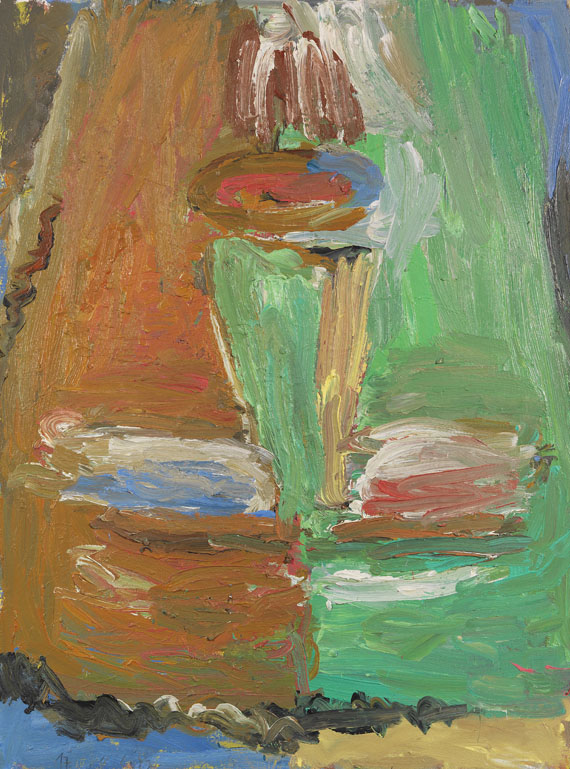867
Georg Baselitz
Das Abgarbild, 1984.
Oil on canvas
Estimate:
€ 180,000 / $ 212,400 Sold:
€ 425,000 / $ 501,500 (incl. surcharge)
Das Abgarbild. 1984.
Oil on canvas.
Lower left monogrammed and dated "17.III.84". Verso signed, once more dated "17.III.84" and titled "das Abgarbild". 130 x 97 cm (51.1 x 38.1 in).
The large-size paintings from his early period of creation, which reaches into the 1980s, count among his most sought-after works on the international auction market.
The work's authenticity has kindly been confirmed orally by the Atelier Georg Baselitz. We are grateful for their kind support in cataloging this lot.
PROVENANCE: Galerie Michael Werner, Cologne.
Galerie Neher, Essen.
Private collection Hamburg (acquired from aforementioned in 1988).
EXHIBITION: Deutsche Kunst im 20. Jahrhundert, Galerie Neher, Essen, vol. 2, 1987, pp. 16/17, with illu.
Blickpunkte Deutscher Kunst im 20. Jahrhundert, 12 November 1988 – 7 January 1989, pp. 18/19, with illu.
Gegenwart Ewigkeit. Spuren des Transzendenten in der Kunst unserer Zeit, Martin-Gropius-Bau, Berlin, 7 April 1990 – 24 June 1990, p. 135, illu. 7 (with label on frame).
"I was occupied with it (the Abgar head) when I suddenly did something in my pictures that I had never done before, when I painted a head the size of the canvas, and I realized that the head showed no physical contour, no volume, that it was flat and larger than life, the nose at the image’s center, the left and the right side of the face separated and the separation emphasized by contrary colors.“ (Baselitz, quote after: Ex. cat. Kunsthalle Bielefeld, Georg Baselitz – Vier Wände, published by Ulrich Weisner, Bielefeld 1985, p. 14.)
Oil on canvas.
Lower left monogrammed and dated "17.III.84". Verso signed, once more dated "17.III.84" and titled "das Abgarbild". 130 x 97 cm (51.1 x 38.1 in).
The large-size paintings from his early period of creation, which reaches into the 1980s, count among his most sought-after works on the international auction market.
The work's authenticity has kindly been confirmed orally by the Atelier Georg Baselitz. We are grateful for their kind support in cataloging this lot.
PROVENANCE: Galerie Michael Werner, Cologne.
Galerie Neher, Essen.
Private collection Hamburg (acquired from aforementioned in 1988).
EXHIBITION: Deutsche Kunst im 20. Jahrhundert, Galerie Neher, Essen, vol. 2, 1987, pp. 16/17, with illu.
Blickpunkte Deutscher Kunst im 20. Jahrhundert, 12 November 1988 – 7 January 1989, pp. 18/19, with illu.
Gegenwart Ewigkeit. Spuren des Transzendenten in der Kunst unserer Zeit, Martin-Gropius-Bau, Berlin, 7 April 1990 – 24 June 1990, p. 135, illu. 7 (with label on frame).
"I was occupied with it (the Abgar head) when I suddenly did something in my pictures that I had never done before, when I painted a head the size of the canvas, and I realized that the head showed no physical contour, no volume, that it was flat and larger than life, the nose at the image’s center, the left and the right side of the face separated and the separation emphasized by contrary colors.“ (Baselitz, quote after: Ex. cat. Kunsthalle Bielefeld, Georg Baselitz – Vier Wände, published by Ulrich Weisner, Bielefeld 1985, p. 14.)
The motif of the "Abgarkopf" (Abgar Head) is part of a small series of similar Abgar pictures from 1984 in which Baselitz confronts us with Christ's visage in the upside-down manner that became characteristic of his paintings from 1969 on. In the early 1980s Baselitz found decisive input in early Christian art, less for its iconographic contents but for the occupation with the origin of images itself. In this context the artist examined the image of Christ, as well as other Christian motifs, such as the "Crucifixion" or "The Veil of Veronica". Just as it is the case with the sudarium of St. Veronica, the Abgar picture is also a "Vera Icon" – a true image of Christ and not manmade. The legend of Abgar is about the healing of Abgarus V. of Edessa with a cloth with an impression of Christ’s face, today the Vatican considers it the oldest known representation of Jesus Christ. In addition, the image is also regarded an "acheiropoieton“, an image not created by the hand of man. Baselitz uses it as a kind of legend for the origins of painting and shapes it as an independent image type, which, due to the formal reduction to the essential elements, calls reminiscence of the faces in Jawlenky's famous Meditations, however, only as far as the dynamic brushstrokes are concerned. The artist refined this concept to abstraction in his small format (see illu.). Baselitz' monumental painting "Abgar Head" treats the art-historical tradition of the image of Christ playfully and takes the original image of art toModernism: By making the image of Christ subject to his own pictorial language, presenting it not only in a monumental format but also upside-down, Baselitz breaks with precedent in the most striking manner, creating a visual manifestation of his own artistic progressiveness that is of epic significance for art history. [JS]
867
Georg Baselitz
Das Abgarbild, 1984.
Oil on canvas
Estimate:
€ 180,000 / $ 212,400 Sold:
€ 425,000 / $ 501,500 (incl. surcharge)
Headquarters
Joseph-Wild-Str. 18
81829 Munich
Phone: +49 89 55 244-0
Fax: +49 89 55 244-177
info@kettererkunst.de
Louisa von Saucken / Undine Schleifer
Holstenwall 5
20355 Hamburg
Phone: +49 40 37 49 61-0
Fax: +49 40 37 49 61-66
infohamburg@kettererkunst.de
Dr. Simone Wiechers / Nane Schlage
Fasanenstr. 70
10719 Berlin
Phone: +49 30 88 67 53-63
Fax: +49 30 88 67 56-43
infoberlin@kettererkunst.de
Cordula Lichtenberg
Gertrudenstraße 24-28
50667 Cologne
Phone: +49 221 510 908-15
infokoeln@kettererkunst.de
Hessen
Rhineland-Palatinate
Miriam Heß
Phone: +49 62 21 58 80-038
Fax: +49 62 21 58 80-595
infoheidelberg@kettererkunst.de
We will inform you in time.




 Lot 867
Lot 867 

